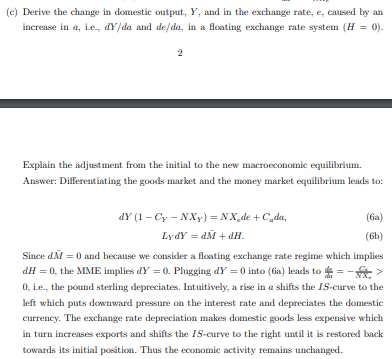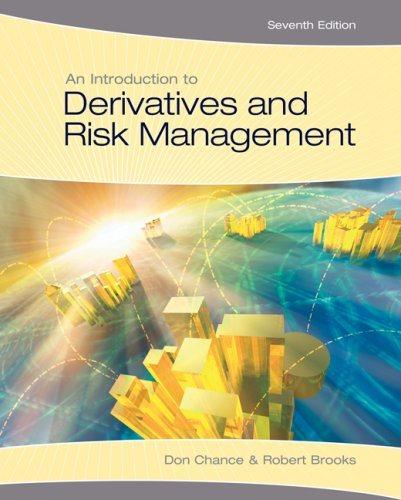Hi I do not understand the differentiation in part B and C, and therefore do not understand the questions at all. Further explanation on how to derive them and what that allows would be great, thanks.



b) Derive the change in output and in foreign currency reserves caused by an increase in a, i.e., dY/da and dH/da, in a fixed exchange rate system. Next, determine the devaluation of the domestic currency, dE/da which is necessary to keep the economic activity unchanged, i.e., such that dY=0. Answer. In a fixed exchange rate regime, the exchange rate becomes an exogenous variable, i.e., =e~, while the change in the stock of international reserves is an endogenous variable. Like previously, perfect capital mobility implies that the domestic interest rate must stick to the foreign interest rate, r. The BoP equilibrium implies that dr=rr=0 and thus we can focus on the goods and money market equilibrium. Differentiating the goods market and the money market equilibrium leads to: dY(1CYNXY)=NXede+Cada,LYdY=dM+dH. Keeping first the exchange rate fixed, i.e., setting de=0, the GME (5a) can be solved for the change in output, i.e., dadY=CYNXYC00. 2. Depression and Monetary Policy in Open Economy Let us consider an open economy which has removed all barriers to capital mobility. The open economy comprises three agents: bouseholds, firms and monetary authorities. We denote GDP by Y, the domestic interest rate by r, the exchange rate (i.e., the pound 1 sterling price of one euro) by e (a rise in e means a depreciation of the pound sterling), and the world interest rate by r. Prices are fixed and normalized to unity. The goods market is described by Y=C(Y,a)+I(r)+NX(Y,e) where C is households' final consumption expenditure, I investment, NX net exports. We assume that housebolds have a preference for wealth as captured by the parameter a. When a takes higher values, consumption falls as households want to save more, i.e., Ca=dadC0,NXY0. (a) Show graphically the effects of a rise in a in a fixed exchange rate regime (H=0) in the (Y,r)-space. Explain the adjustment from the initial to the new macroeconomic equilibrium. Answer. Whilst the rise in a leads to a fall in consumption which tends to depreciate the domestic currency, the central bank meets additional demand for the foreign currency to keep its parity fixed. The counterpart of meeting this additional demand for the foreign currency is a fall in international reserves. This fall in the stock of foreign currency shifts the LM-curve to the left which amplifies the initial negative effect (c) Derive the change in domestic output, Y, and in the exchange rate, e, cansed by an increase in a, Le., dY/da and de/da, in a floating exchange rate system (H=0). 2 Explain the adjustment from the initial to the new macroeconomic equilibrium. Answer: Different iating the goods market and the money market equilibrium leads to: dY(1CYNXY)=NXede+Cada,LYdY=dM+dH. Since dM=0 and because we consider a floating exchange rate regime which implies dH=0, the MME implies dY=0. Plugging dY=0 into (6a) leads to cd=NXC> 0 , i.e., the pound sterling depreciates. Intuitively, a rise in a shifts the IS-curve to the left which puts downward pressure on the interest rate and depreciates the domestic currency. The exchange rate depreciation makes domestic goods less expensive which in turn increases exports and shifts the IS-curve to the right until it is restored back towards its initial position. Thus the economic activity remains unchanged









